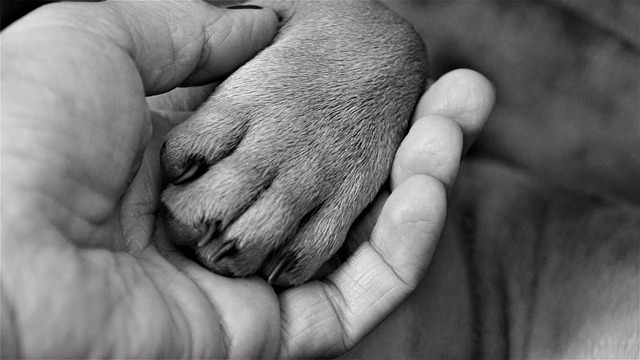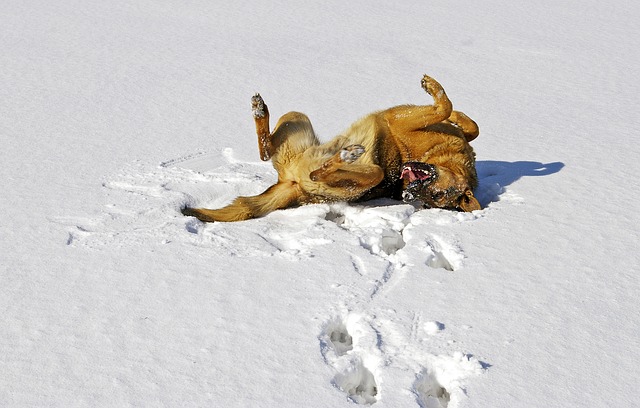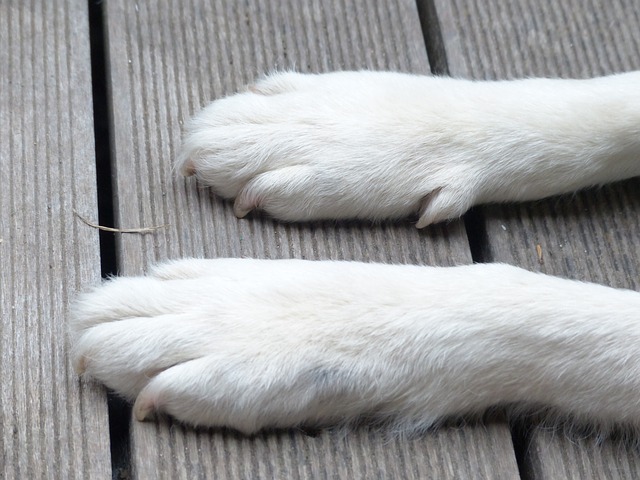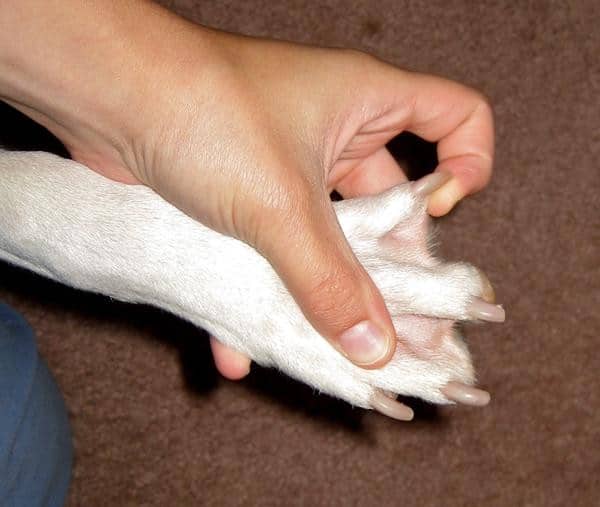A dog’s coat color, eyes, ears, and stature often get more attention than his feet.
A good number of dog owners out there don’t have a clue about the shape of their Fido’s paws. Many of them imagine that all canines have the same feet.
However, this is terribly false. Dog breeds come with different types of feet.
Knowing which type of paws your pup has may seem insignificant but it really isn’t.
Turns out certain types of feet among canines are considered to be faults.
So, when choosing a puppy or buying a dog from a breeder, should you be worried that he has a webbed or non-webbed feet?
Well, in this post, we will explore webbed dog feet vs non-webbed just to give you a better understanding of your Fido’s paws.
Types of paws
Before we delve deeper into the subject, it’s a great idea to go over the basics.
Ideally, dog feet are characterized into three major categories:
Cat’s Feet

The term “cat’s feet” implies a pooch that has retractable claws, like those of a cat. Well, the truth is that this type of feet simply refers to neat and round paws.
If you’ve seen cat’s paws before, you know they are both round and compact, hence the name.
Cat’s feet also have high-arched toes tightly held together.
A dog with a cat’s feet performs very well when put in an endurance training program.
The short third digital bones in this type of feet don’t need a lot of energy to lift off the ground.
Dogs with these types of feet can run, jump, and trot the countryside all day long without throwing in the towel.
In addition, this type of paw enhances a good grip and helps a dog to evade injuries when walking on rough terrains.
Finally, these types of feet are more stable and can bear great weight.
Catlike paws are common in working dog breeds that are bred to have increased endurance in the field like Dobermans, Akitas, Kuvasz, and Giant Schnauzer.
Hare Feet

Like the cat’s feet above, these are paws that are similar in shape to hare or rabbit’s feet.
A hare-footed canine features two middle toes that are longer than the outer toes.
Essentially, the toes arch less, making them appear to be longer than average.
More energy is needed to lift these types of paws, especially when compared to catlike paws.
However, they offer the advantage of increased speed. Dog breeds with hare feet can spring into action fast (like hares) and reach great speeds.
Examples of dogs with this type of feet include whippet, Borzoi, and Greyhound. Learn more here: 10 Dog Breeds with Hare Feet
Webbed Feet

The last category of dog paws is webbed feet.
As the name suggests, dogs with webbed feet have a special web or skin membrane connecting their toes.
In other words, these dogs have excessive skin between their toes just like a duck’s feet.
Unlike a duck’s feet, however, the paws only manifest partial webbing.
Just like wearing a pair of flippers in water, dogs with webbed feet are great swimmers—they can paddle longer distances in water without drowning.
The webs also offer protection and enhance gripping during walks, especially during winter.
The most popular breed with webbed feet is none other than America’s favorite, the Labrador retriever. Others include:
- Newfoundland
- Redbone Coonhounds
- Chesapeake Bay retriever
- Portuguese water dog
- Irish Water Spaniel
- Dachshund
- Nova Scotia Duck-Tolling Retriever
- Otterhounds
- Poodle
Webbed Dog Feet Vs Non-Webbed
Now that you have an idea of the three types of dog feet, let’s talk about webbed dog feet vs non-webbed.
1. Dog Paw Webbing Isn’t All That Uncommon
While most people tend to think that webbed foot is a paw pattern or trait that is unique to certain breeds, it is not the case.
Almost every dog has some kind of webbing between their toes. If you run your fingers in between your pup’s toes today, you will feel a thin membrane between his toes. That’s what is commonly referred to as webbed feet.
So, the dog paw webbing feature isn’t all that uncommon! It is part of how dog paws are composed just like humans have some skin between their fingers.
However, certain breeds take the degree of webbing to a whole new level. They have more pronounced webbing between their toes to help them do specific things common to their respective breeds.
In most cases, dogs with a significant amount of webbing are water dogs and webbing boosts their agility in water. However, not all dogs with webbed feet use them for swimming.
Essentially, all land animals are born with webbed feet. However, the webbing membrane often goes away during their developmental cycles.
Dogs with pronounced webbings have been bred over the years to retain this trait. Certain dog breeds have worked throughout history to retrieve game and water animals.
Evolutionary changes and selective breeding have made it possible for these breeds to take water agility to a whole new level—they can swim faster and have better control in water than other dog breeds.
2. Swimming Prowess

Any animal that spends most of his time in the water is bound to have a webbing effect on their feet. These include frogs and ducks.
The membrane in the middle of their toes allows these dogs to move through water fast and efficiently than those without webbed feet. The skin makes the foot wide and flat thereby adding to the surface area.
With an increased surface area, the pooch can swim in water at a faster pace. A dog without webbing has a rather hard time navigating his way in the water because he will have to tear through it.
Put simply, if you choose a puppy with webbed feet, there are high chances that he will be able to swim better and efficiently in most water bodies.
So, if you are interested in a dog that can help you retrieve objects (or even people) in water, go for those with more pronounced webbed feet.
However, this does mean that the webbing effect is as prominent in dogs as it is in other water creatures.
No! Dogs only manifest partial webbing, which comes with certain advantages like better water agility.
3. All-terrain Dogs
In addition to swimming advantages, webbed feet also allow a dog to roam all terrains quite efficiently.
See, a canine with non-webbed feet can easily slip on slicky terrains and sink in boggy areas.
On the other hand, webbed dog feet make a canine sure-footed and prevent them from getting stuck in mushy areas.
The webbing acts like a net that firm up the grip between the pooch and the ground. It helps the dog to maintain stability and not sink.
So, webbed feet are also helpful for a dog that is going to live or work in swampy areas—you are not going to see such a dog slip or slide around in mud.
4. Digging
The web or skin membrane also function like shovel blades, allowing dogs with webbed feet to move dirt around with ease compared to their non-webbed feet counterparts.
A dog with normal feet solely relies on his claws to dig things up, which means he will need more time than one with webbing.
If you want a hunting dog to help you dig prey up, you might want to go for one with webbed feet.
On the flip side, if you want a dog that won’t stress you with digging your yard, under the fence, floor, or furniture, one with non-webbed feet is a better option.
5. Stuck Snow

While webbed feet are good snow boots during winter, they may also allow snow to get stuck inside the dog’s feet.
Dogs with non-webbed feet are less likely to experience this phenomenon because their toes don’t have excess membranes in between them.
If you walk a dog with webbed feet outside during winter, be sure to clean his paws when you go back home.
Else, ensure he wears snow boots every time you leave the house when it’s snowing.
And speaking of cleaning your pup’s paws when you get home, check out the following posts for our recommendation of the best paw cleaners and washers in the market right now:
6. Health Concerns
While not all dogs with webbed feet have health complications, some are unfortunately predisposed to certain ailments.
Ideally, webbing denotes the fusion of dog’s toes via skin and soft, fibrous tissues (simple syndactyly) or bones (complex Syndactyly).
In the latter case, a dog can increase his likelihood of instability which may ultimately trigger arthritis.
According to dogsaholic.com, other conditions that may come about as a result of webbing include:
- Cleft Palate: Apparently, cleft palate and the emergence of webbed feet in dogs are results of chromosomal mutations. It is believed that the same genetic abnormality that causes pronounced tissue unions in areas where there shouldn’t be any (like in a dog’s feet) fails to unite parts in the dog’s body that should stick together such as a dog’s palate or mouth roof.
- Shortened tibia-fibula: This is a condition that is associated with premature closure of the tibia and the fibula, bones on the lower rear leg of a dog. Like cleft palate, it is believed that the genes that result in pronounced webbing in dogs is responsible for the untimely joining of the two bones.
- Scoliosis: Given that a dog with syndactyly may not walk right, there are high chances that he can suffer from scoliosis
On the other hand, a dog without webbed feet is spared from all the trouble surrounding webbing.
Besides, while dogs with non-webbed feet can suffer from tick and fleas infestation from time to time, those with the webbing feet trait seem to be more prone to ticks, fleas, and a host of other parasites.
When playing outdoors, ticks and fleas find their way on the membrane between these dogs’ toes and stay there. If not checked on time, the membrane can easily develop abscesses.
If you are hearing the term for the first time, abscesses are localized infections of the skin—like severely infected boil or pimple on the face.
So, when we say that webbed feet may develop abscesses, we are referring to painful, pus-filled blisters that may occur in the webbing membrane between a dog’s toes.
By the way, don’t let pesky ticks or fleas ruin your pup’s day. Explore our informative posts below for effective solutions to kick these critters to the curb.
50 Home Remedies to Get Rid of Fleas on Your Dog
7. Show Ring conformation Concerns

Most dog show judges consider paw shape as a major fault because all body parts are expected to work in synchrony for a dog to achieve efficient gait.
For starters, a fault is an aspect of temperament, movement, or appearance that is considered to be detrimental to a dog bred.
And they can be major faults (can prevent a dog from being showcased in the conformation ring) or minor faults (can be corrected by careful breeding).
Paw shape faults may comprise the structural harmony of a dog, causing major gait abnormalities.
Dog breeds that are expected to have pronounced webbed feet pattern include the Portuguese water dog, Portuguese water dog, Nova Scotia Duck Tolling Retriever, and Newfoundland.
So, if you are planning to participate in dog shows and the puppy you want to purchase from a breeder isn’t among the mentioned breeds but has webbed feet, you should be concerned.
Recommended: How Much Do Dog Show Winners Make?
When should you worry about webbed dog feet vs. non-webbed?

Now that you know the differences between webbed and non-webbed dog feet, when should it be a concern?
Well, the most important thing is to identify the purpose of your dog or why you want to keep a dog.
If you are simply looking for a domestic companion, webbing shouldn’t concern you.
However, if you are keeping a dog for water-related activities, hunting, herding, and outdoor activities, then webbing should be a concern.
Since a working dog will have to swim, walk, or run in difficult terrains, webbed feet will go a long way in helping him maintain stability, ultimately boosting his performance.
The above-highlighted health conditions may also prompt a new dog owner to opt for a dog with non-webbed feet.
Finally, webbing should also be a concern to you when you plan to participate in dog shows because paw shape and pattern is considered a major fault in many conformation rings.
Conclusion
Whether you have a webbed or non-webbed footed dog, it is apparent that there are both pros and cons that may come with owning a dog with either paw shape.
Knowing the actual type of webbing will help you figure out where his strengths lie and what he can and cannot achieve.
So, you will be able to take better care of your four-legged friend at home or when you hit the outdoors with him.
Related Posts:
As an Amazon Associate, we may receive a small commission from qualifying purchases but at no extra cost to you. Learn more. Amazon and the Amazon logo are trademarks of Amazon.com, Inc, or its affiliates.

